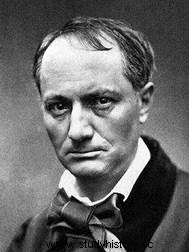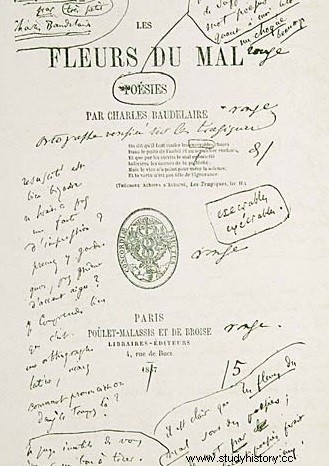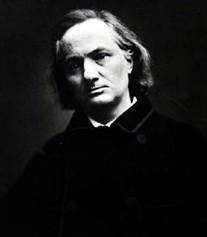 Charles Baudelaire (1821-1867) is one of the great names in 19th century French poetry. His best-known work, The Flowers of Evil , will be worth many legal setbacks to him. The poet and his publisher are condemned for immorality, the themes addressed being considered scandalous. Convinced that society is not ready to welcome his work, Charles Baudelaire feels he is a “cursed” poet. Both a precursor of a modern aesthetic described as "supernaturalism" and a recognized literary critic, he served as a model for many French poets, including the brilliant Paul Verlaine and Arthur Rimbaud .
Charles Baudelaire (1821-1867) is one of the great names in 19th century French poetry. His best-known work, The Flowers of Evil , will be worth many legal setbacks to him. The poet and his publisher are condemned for immorality, the themes addressed being considered scandalous. Convinced that society is not ready to welcome his work, Charles Baudelaire feels he is a “cursed” poet. Both a precursor of a modern aesthetic described as "supernaturalism" and a recognized literary critic, he served as a model for many French poets, including the brilliant Paul Verlaine and Arthur Rimbaud .
Baudelaire, from Dandy to poet
Charles Baudelaire was born in Paris on April 9, 1821. His father, an amateur painter, died in 1827. His mother remarried the following year to General Aupik, to the great despair of Charles. Placed first in boarding school in Lyon, he then studied at the Louis-le-Grand high school in Paris, where he distinguished himself by his indiscipline. He is nevertheless passionate about romanticism and the work of Théophile Gautier.
After obtaining his baccalaureate, resolved to devote himself to writing, Baudelaire began a carefree and bohemian life in the Latin Quarter until 1841. To bring him back to the right path, his father sent him on a trip to India. From this journey, which will go no further than Reunion, the young Baudelaire brings back the first poems of his main collection, the Flowers of Evil, as well as a certain taste for exoticism which will never leave him.
 Back in France, Baudelaire fell in love with Jeanne Duval in 1842, a mulatto girl with whom he shared until the end of the erratic life and which he will set up as the muse, the "Black Venus" of his work. This liaison, however, did not prevent the poet from pursuing other women to whom he dedicated fiery poems.
Back in France, Baudelaire fell in love with Jeanne Duval in 1842, a mulatto girl with whom he shared until the end of the erratic life and which he will set up as the muse, the "Black Venus" of his work. This liaison, however, did not prevent the poet from pursuing other women to whom he dedicated fiery poems.
Settled on Île Saint-Louis, Baudelaire, abusing his paternal heritage, lives, like the dandies, spending indecent sums on his eccentric outfits or the acquisition of 'works of art. Idle esthete, he continues to write poetry as a dabbler, begins to frequent Théophile Gautier with whom he shares a marked attraction for the Artificial Paradises and Théodore de Banville. His way of life is not long in beginning his inheritance:to avoid the squandering of his fortune, his stepfather and his mother place him under legal guardianship. Baudelaire, suffering from then on not being able to live freely, took it into his head to live from his pen.
From Edgar Poe to the Flowers of Evil
It is thus the need for money that pushes him to engage in art criticism. Quickly excelling in this field, on the lookout for the most surprising novelties, he published in various magazines, poems but also literary essays as well as a short story. In 1848 he briefly participated in the revolutionary events in Paris before embarking on the translation of the works of Edgar Allan Poe. Baudelaire feels for the American author a great admiration mixed with a boundless attraction for the imagination he develops.
In June 1857, Baudelaire, then a recognized poet but on bad terms with the imperial regime, had the Fleurs du mal published, his masterpiece bringing together poems already published in reviews and fifty-two unpublished works (including the famous Pictures in Paris ). This collection of poems earned him being condemned the same year for "offending religious morality" and "outrage against public morality and good morals" (like Flaubert for Mme Bovary).
Forced to pay a heavy fine and withdraw several poems, Baudelaire emerged weakened from this ordeal.
The bitterness of recent years
After the Fleurs du mal scandal, Baudelaire, still in debt, continued to publish in review his critical texts and his translations, to which the prose poems will soon be added, which will be grouped together and published in their final form after his death, under the title Petits Poèmes en prose. Les Petits Poèmes en prose are the counterpart to Les Fleurs du mal, whose theme they take up, but this time in a poetic, sensual and surprisingly musical prose.
 With the Petits Poèmes en prose (whose original title was the Spleen de Paris), Baudelaire definitively broke with the classical and romantic aesthetics, imposing new poetic standards. This disillusioned work, breaking with a certain faith in progress, will subsequently inspire generations of poets and is still today one of the peaks of this mode of artistic expression.
With the Petits Poèmes en prose (whose original title was the Spleen de Paris), Baudelaire definitively broke with the classical and romantic aesthetics, imposing new poetic standards. This disillusioned work, breaking with a certain faith in progress, will subsequently inspire generations of poets and is still today one of the peaks of this mode of artistic expression.
Still in difficulty with the academic community and the French authorities, Baudelaire moved to Belgium for a few years, where he intended to pay off his debts. Unkind to the bourgeoisie of a country he considers artificial, the embittered poet begins a cycle of disappointing lectures. In the spring of 1866, Baudelaire, already ill, had a serious illness in Namur. The consequences are irremediable:suffering from paralysis and aphasia, the poet is brought back to Paris in July. He died there a year later, on August 31, 1867, certainly penniless, but leaving behind him an invaluable artistic heritage...
Main works of Baudelaire
- The Flowers of Evil (1857)
- Le Spleen de Paris:Little poems in prose (1869)
Bibliography
- A singular man:Charles Baudelaire by Madeleine Lazard. Arlea, 2010.
- Charles Baudelaire by Walter Benjamin. Payot, 2002.
